New World warbler
| New World warbler | |
|---|---|

| |
| Prothonotary warbler (Protonotaria citrea) | |
| Scientific classification | |
| Domain: | Eukaryota |
| Kingdom: | Animalia |
| Phylum: | Chordata |
| Class: | Aves |
| Order: | Passeriformes |
| Superfamily: | Emberizoidea |
| Family: | Parulidae Wetmore et al., 1947 |
| Type genus | |
| Parula Bonaparte, 1838
| |
| Synonyms | |
|
Mniotiltidae | |
The New World warblers or wood-warblers are a group of small, often colorful,
This group likely originated in northern
The scientific name for the family, Parulidae, originates from the fact that
Taxonomy
| |||||||||||||||||||||||||||||||||||||||||||||||||||||||||||||||||||||||||||||||||||||||||||||||||||||||||
| Cladogram showing the relationships between the genera[1][2] |
The family Parulidae was introduced for the New World warblers in 1947 by American ornithologist
The family was formerly thought to be
A
A large clade that included the 29 species then placed in the genus Dendroica, also included four species of Parula, one of the three species of Wilsonia and the
The species that had traditionally been placed in Basileuterus formed two clades. One group retains the genus name as it includes the golden-crowned warbler, the type species for the genus. The other larger group, now with 18 species, is placed in the resurrected genus Myiothlypis Cabanis, 1850, as it contains the type species, the black-crested warbler.[1][2]
The genus
Extant Genera
The family Parulidae now contains 120 species divided into 18 genera.[1]
| Image | Genus | Living Species |
|---|---|---|
 |
Seiurus Swainson, 1827 |
|
 |
Helmitheros Rafinesque, 1819 |
|
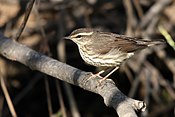 |
Parkesia Sangster, 2008 |
|
 |
Vermivora Swainson, 1827 |
|
 |
Mniotilta Vieillot, 1816 |
|
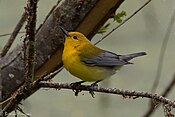 |
Protonotaria Baird, 1858 |
|
 |
Limnothlypis Stone, 1914 |
|
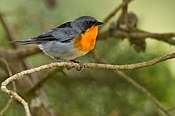 |
Oreothlypis Ridgway, 1884 |
|
 |
Leiothlypis Sangster, 2008 |
|
 |
Leucopeza Sclater, 1876 |
|
 |
Oporornis Baird, 1858 |
|
 |
Geothlypis Cabanis, 1847 |
|
 |
Catharopeza P.L. Sclater, 1880 |
|
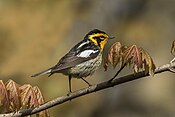 |
Setophaga Swainson, 1827 |
|
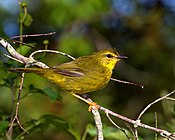 |
Myiothlypis Cabanis, 1850 |
|
 |
Basileuterus Cabanis, 1848 |
|
 |
Cardellina Bonaparte, 1850 |
|
 |
Myioborus Baird, 1865 |
|
Former species
Some species that were previously placed in the Parulidae have been moved to other families:[1][2][4]
- Olive warbler (Peucedramus taeniatus) – now in own family Peucedramidae
- Yellow-breasted chat (Icteria virens) – now in own family Icteriidae
- Three species in the genus Granatellus – now in the family Cardinalidae
- Red-breasted chat (Granatellus venustus)
- Grey-throated chat (Granatellus sallaei)
- Rose-breasted chat (Granatellus pelzelni)
- Wrenthrush (Zeledonia coronata) – now in own family Zeledoniidae
- Two species endemic to Hispaniola – now in family Phaenicophilidae
- Green-tailed warbler (Microligea palustris)
- White-winged warbler (Xenoligea montana)
- Two species endemic to Cuba in the genus Teretistridae
- Yellow-headed warbler (Teretistris fernandinae)
- Oriente warbler (Teretistris fornsi)
Description
All the warblers are fairly small. The smallest species is
The migratory species tend to lay larger clutches of eggs, typically up to six, since the hazards of their journeys mean that many individuals will have only one chance to breed. In contrast, the laying of two eggs is typical for many tropical species, since the chicks can be provided with better care, and the adults are likely to have further opportunities for reproduction.
Many migratory species, particularly those which breed further north, have distinctive male plumage at least in the breeding season, since males need to reclaim territory and advertise for mates each year. This tendency is particularly marked in the large genus Setophaga (formerly Dendroica). In contrast, resident tropical species, which pair for life, show little if any sexual dimorphism, but exceptions occur. The Parkesia waterthrushes and ovenbird are strongly migratory, but have identical male and female plumage, whereas the mainly tropical and sedentary yellowthroats are dimorphic. The Granatellus chats also show sexual dimorphism, but due to recent genetic work, have been moved into the family Cardinalidae (New World buntings and cardinals).
The name warbler is a misnomer for the New World group of warblers established before the family was split from the Old World warbler in the 1830s. The Random House Dictionary defines "to warble" as "to sing with trills." Most New World warblers do not warble, but rather "lisp, buzz, hiss, chip, rollick, or zip."[6]
References
- ^ Rasmussen, Pamela, eds. (July 2023). "New World warblers, mitrospingid tanagers". IOC World Bird List Version 13.2. International Ornithologists' Union. Retrieved 22 November 2023.
- ^ PMID 20696258.
- JSTOR 4080390.
- ^ S2CID 53058340.
- PMID 30936315.
- ^ Harrison, Hal H. (1984). Wood Warblers' World. New York City: Simon & Schuster. p. 17.
Further reading
- Curson, Quinn and Beadle, 1994. New World Warblers. 252 p. ISBN 0-7136-3932-6
- Dunn, Jon L.; Garrett, Kimball L. (1997). A Field Guide to Warblers of North America. Boston: Houghton Mifflin. ISBN 978-0-395-78321-4.
- Harrison, Hal H. 1984. Wood Warblers’ World. New York : Simon and Schuster, 335 p., 24 p. of plates : ill. (some col.) ; 25 cm.
- Lovette, I. J. and E. Bermingham. 2002. What is a wood-warbler? Molecular characterization of a monophyletic Parulidae. The Auk. 119(3): 695–714. PDF fulltext[permanent dead link]
- Morse, Douglass H. 1989. American Warblers : an Ecological and Behavioral Perspective. Cambridge, Massachusetts : Harvard University Press, xii, 406 p. : ill., maps.
External links
- New World warblers (Parulidae) information, including 81 species with videos and 100 with photographs at the Internet Bird Collection
- "Chasing Down Warblers" National Geographic News story on seeing 30 warbler species in May 2002
